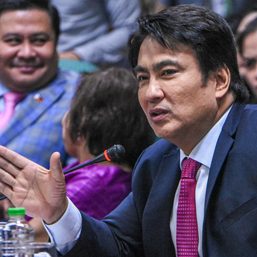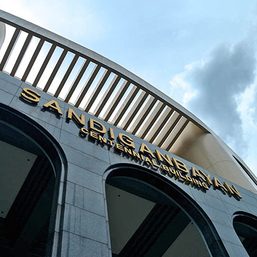SUMMARY
This is AI generated summarization, which may have errors. For context, always refer to the full article.
![[ANALYSIS] How the TRAIN law worsened poverty, inequality](https://www.rappler.com/tachyon/r3-assets/612F469A6EA84F6BAE882D2B94A4B421/img/8E6C4AD71C85412E809A4A8E8BE65837/how-the-train-law-worsened-poverty-inequality-april-25-2019.jpg)


Despite the importance of the Tax Reform for Acceleration and Inclusion (TRAIN) law, we don’t hear much about it from the administration’s senatorial bets.
If you recall, back in December 2017, lawmakers touted TRAIN as the Duterte government’s “best Christmas and New Year’s gift” for the Filipino people, a milestone in the country’s tax reform history.
But aside from the public backlash that TRAIN met last year – when inflation shot up to record highs – two studies by researchers at the Philippine Institute for Development Studies (PIDS) show that TRAIN worsened the plight of millions of Filipinos.
Specifically, using numerical simulations, the studies demonstrate that TRAIN likely worsened poverty and income inequality in the country.
In this article let’s unpack these two important studies and the conclusions they arrived at.
Worse poverty
First, Dr. Philip Tuaño and 4 other economists originally sought to assess the impact of specific components of TRAIN: its higher excise taxes on coal and petroleum products.
But with the benefit of more inputs, their discussion paper evolved to estimate the impacts of TRAIN as a whole, including other key components like the lowering of personal income tax rates.
Estimating the effects of a major policy can prove devilishly tricky because of the overwhelming complexity of any economy.
But by developing a toy model of sorts for the economy – using so-called “computable general equilibrium” – economists can try to approximate what happens to most parts of an economy when you tweak just one.
There are lots of results to unpack from the study, but here let’s focus on welfare and poverty.
Figure 1 shows that government will have to give a lot of money to make the poor at least as well-off as they were before TRAIN.
To be fair, the need for such compensation abates when you account for the unconditional cash transfers that TRAIN gives out to the poorest 50% of households. According to latest data, 9.2 million out of the 10 million target households already got their money, albeit belatedly.
Figure 1
More to the point, the paper also found that TRAIN likely exacerbated Philippine poverty (by 0.26 percentage point) even with the cash transfers in place. The same goes for a host of various sectors in the economy, most especially fisherfolk (Figure 2).
Notably, the Pantawid Pasada transfers included in TRAIN likely reduced poverty in the transport sector. Dr. Tuaño reasons many drivers and operators are found just below the poverty line, so even modest transfers could lift many of them out of poverty.
The same, unfortunately, cannot be said of other sectors.
Figure 2
Philippine poverty went down by a significant 6.6 percentage points from 2015 to 2018, based on latest government data.
But because TRAIN is demonstrably anti-poor, it’s entirely possible that said reduction in poverty would have been larger had it not been for TRAIN. (To validate this, we need to wait for the forthcoming results of the Family Income and Expenditure Survey conducted last year.)
Worse inequality
Perhaps more disquietingly, income inequality also likely worsened due to TRAIN.
Proponents used to trumpet that TRAIN would improve the tax system’s “progressivity,” meaning TRAIN will at once go harder with the incomes of the rich and go easier on the incomes of the poor.
At best, tax reform can indeed be a potent tool for government to level the incomes of the rich and poor. Yet data suggest the opposite happened with TRAIN.
In a separate paper, Dr. Chat Manasan showed that just because TRAIN slapped a higher top marginal tax rate (from 32% to 35%), it doesn’t necessarily mean TRAIN made the tax system more progressive overall.
In fact, TRAIN arguably made it less so.
Effectively, the higher top marginal tax rate hurts only super rich Filipinos, or those earning P12 million or more per year. By contrast, the bulk of TRAIN is still borne by people at the opposite end of the income spectrum, or the poorest Filipinos.
One reason is that many among the poor – say, minimum wage earners or those working in the informal sector as taho vendors or pedicab drivers – were exempt from or not paying income taxes to begin with.
Second, some of TRAIN’s excise taxes were designed by lawmakers to favor the rich, often at the expense of the poor.
For instance, because of TRAIN, the excise tax on automobiles now goes down with the selling price of a car. Some of the biggest winners from TRAIN, therefore, are those who can afford luxury cars and SUVs. (READ: How lawmakers gifted themselves with tax cuts on luxury cars)
Lower estate and donor’s taxes also likely benefitted many rich, landholding, and elite families (we need more data to confirm this).
But all hope is not lost. When I asked Dr. Manasan in a forum whether the diminished progressivity of the tax system owing to TRAIN is fleeting or permanent, she said in any case this can still be corrected if government spends the people’s money progressively.
That is, even if the poor end up losing in the tax reform package, government can at least make sure its various programs disproportionately benefit the poor.
But is this the case? Can we say with confidence that the various flagship projects of the Duterte administration – like the war on drugs, the free tuition law, and Build, Build, Build – redound largely to the benefit of the poor rather than the rich?
At least for the above policies I listed, the answer is an emphatic “no.”
TRAIN as a key election issue
Sure, estimates of TRAIN’s economic impacts are by no means set in stone, and can still be improved.
PIDS itself is cooking up a new model of the Philippine economy that promises to be the most comprehensive ever, and researchers soon plan to redo their estimates of TRAIN’s impacts using this pathbreaking model.
But even now there’s ample evidence – anecdotal and empirical – that TRAIN has worsened poverty and income inequality, thus belying some of its purported welfare benefits.
Keep in mind that a number of lawmakers seeking reelection today advocated for the TRAIN law or otherwise helped push it forward. In the process, they knowingly benefitted from it at the expense of a huge segment of the Filipino people.
Let us not lose sight of this fact on May 13. – Rappler.com
The author is a PhD candidate at the UP School of Economics. His views are independent of the views of his affiliations. Follow JC on Twitter (@jcpunongbayan) and Usapang Econ (usapangecon.com).
Add a comment
How does this make you feel?



![[OPINION] Jailing Jinggoy](https://www.rappler.com/tachyon/2024/01/tl-jailing-jinggoy.jpg?resize=257%2C257&crop=267px%2C0px%2C720px%2C720px)
There are no comments yet. Add your comment to start the conversation.